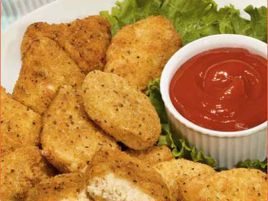Tastes Like Chicken: The Quest for Fake Meat
By John Cloud | Jul 01, 2010

The desire to eat meat has posed an ethical question ever since humans achieved reliable crop production: Do we really need to kill animals to live?
Today, the hunger for meat is also contributing to the climate-change catastrophe. The gases from all those chickens and pigs and cows, and from the manure lagoons that big farms create, are playing a part in global warming. So the idea of fake meat has never been more alluring. What if you could cut into a juicy chicken breast that wasn’t chicken at all but rather some indistinguishable imitation made harmlessly from plant life?
This spring, scientists at the University of Missouri announced that after more than a decade of research, they had created the first soy product that not only can be flavored to taste like chicken but also breaks apart in your mouth the way chicken does: not too soft, not too hard, but with that ineffable chew of real flesh. When you pull apart the Missouri invention, it disjoins the way chicken does, with a few random strands of “meat” hanging loosely.
The vegetarian world is buzzing about the breakthrough in Missouri. “Along with ham, chicken has always been the holy grail,” says Seth Tibbott, 59, the creator of Tofurky and the dean of soy-meat inventors. Tibbott’s Oregon-based Turtle Island Foods has become famous for its surprisingly full-flavored fake turkey. But Tibbott says efforts to create a credible fake chicken have foundered because of chicken’s unique lean texture and its delicate flavor. (“Turkey has a gamier flavor,” he says, “and it’s easier to match stronger flavors.”)
Like his competitors, Tibbott is now investigating whether to buy the Missouri product. A meat analogue that not only looks like chicken but also works in your mouth like chicken has great market potential. According to the Soyfoods
Association of North America, a Washington-based trade group, annual sales of soy products totaled $4.1 billion in 2008, up from $300 million in 1992. But $4.1 billion is, to use a food metaphor, just peanuts. Americans spend something like half a trillion dollars on real meat every year. A meaty-tasting alternative that could capture even a tenth of this market would make someone very rich. The University of Missouri team may finally have cracked the code.
Read more: http://www.time.com/time/magazine/article/0,9171,1993883,00.html?hpt=C2#ixzz0sN2kh76P












